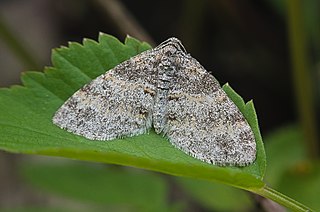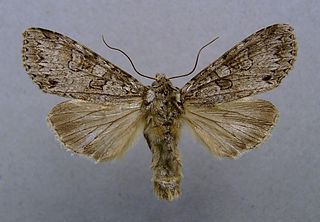
The small fan-footed wave is a moth of the family Geometridae. The species was first described by Johann Siegfried Hufnagel in 1767.

The purple thorn is a moth of the family Geometridae. The species was first described by Johann Siegfried Hufnagel in 1767. It is a species of both Northern Europe and Central Europe. It has a scattered distribution in Britain but is absent from Ireland.

The scalloped oak is a moth of the family Geometridae. The species was first described by Carl Linnaeus in his 1758 10th edition of Systema Naturae.

Chloroclysta siterata, the red-green carpet, is a moth in the family Geometridae. The species was first described by Johann Siegfried Hufnagel in 1767.

Eupithecia innotata, the angle-barred pug, is a moth of the family Geometridae. The species was first described by Johann Siegfried Hufnagel in 1767. It ranges from Spain in the west to western Siberia and Central Asia in the east.

Cyclophora albipunctata, the birch mocha, is a moth of the family Geometridae. The species was first described by Johann Siegfried Hufnagel in 1767. It is found in the Palearctic. The southern boundary runs westward along the French Atlantic coast and to the British Isles and north of the Alps. In the east, the species ranges to the Pacific Ocean. South of the northern Alps line, it is found at some high elevation areas and mountains. In the Pyrenees, the Massif Central, the southern Alps, the northern Dinaric Alps, in the western and northern Carpathians, in northern Turkey and the Caucasus. In the north, the range extends up to the Arctic Circle. In the Far East the nominate subspecies is replaced by Cyclophora albipunctata griseolataStaudinger, 1897.

Biston strataria, the oak beauty, is a moth of the family Geometridae. It is native to Europe, the Balkan countries and the Black Sea region as far as Asia Minor and the Caucasus. The species was first described by Johann Siegfried Hufnagel in 1767. B. strataria is found in a variety of habitats, but is mostly found in woodlands where it rests on the bark of trees, camouflaged by its mottled black and grey wings. The male has feather-like antennae while those of the female are more thread-like. The moth has a wingspan of 40 to 56 mm.

Lobophora halterata, the seraphim, is a moth of the family Geometridae. It was first described by Johann Siegfried Hufnagel in 1767. The species can be found in central and northern Europe and a few localities in southern Europe, Siberia, Amur, Primorye, Sakhalin and Japan.

Plemyria rubiginata, the blue-bordered carpet, is a moth of the family Geometridae found in Europe and across the Palearctic. The moth was first described by the Austrian lepidopterists Michael Denis and Ignaz Schiffermüller in 1775.

Nymphula nitidulata, the beautiful china-mark, is a species of moth of the family Crambidae described by Johann Siegfried Hufnagel in 1767. It is found in Europe, Japan (Hokkaido), Turkey, Armenia, Russia and China.

Asthena is a genus of moths in the family Geometridae.

Hydrelia sylvata, the waved carpet, is a moth of the family Geometridae. It is found throughout the temperate parts of the Palearctic realm.

Scopula rubiginata, the tawny wave, is a moth of the family Geometridae. The species was first described by Johann Siegfried Hufnagel in 1767.

Polia nebulosa, the grey arches, is a moth of the family Noctuidae. The species was first described by Johann Siegfried Hufnagel in 1766. It is found in temperate Europe and Asia up to eastern Asia and Japan. It is not present in northernmost Fennoscandia and the southern parts of the Iberian Peninsula, Italy and Greece. In the Alps it is found at heights up to 1,600 meters.

Carsia sororiata, the Manchester treble-bar, is a moth of the family Geometridae. The species was first described by Jacob Hübner in 1813. It is found in northern and central Europe, the Urals, Siberia, the Far East, northern Mongolia and in North America from Alaska to Newfoundland and to New Hampshire.

Asthena albulata, the small white wave, is a moth of the family Geometridae. It is known from all of Europe and is also present in the Near East.

Catarhoe cuculata, the royal mantle, is a moth of the family Geometridae. The species was first described by Johann Siegfried Hufnagel in 1767. It is found from Europe to western Central Asia and east Siberia. The species prefers to live in light forests and forest edges, but also occurs on meadows.

Euphyia unangulata, the sharp-angled carpet, is a moth of the family Geometridae. It shares its common name with the similarly coloured Neoarctic, Euphyia intermediata.

Lithophane furcifera, the conformist, is a moth of the family Noctuidae. The species was first described by Johann Siegfried Hufnagel in 1766. It is found from central Europe, east to the Black Sea region, the Caucasus and western Siberia. In the mountains, it is found up to elevations of 1,800 meters.

Hydrelia albifera, the fragile white carpet moth, is a moth in the family Geometridae. The species was first described by Francis Walker in 1866. It is found from Newfoundland to British Columbia, south in the east to the Gulf states. The habitat consists of deciduous and mixed-wood forests.





















